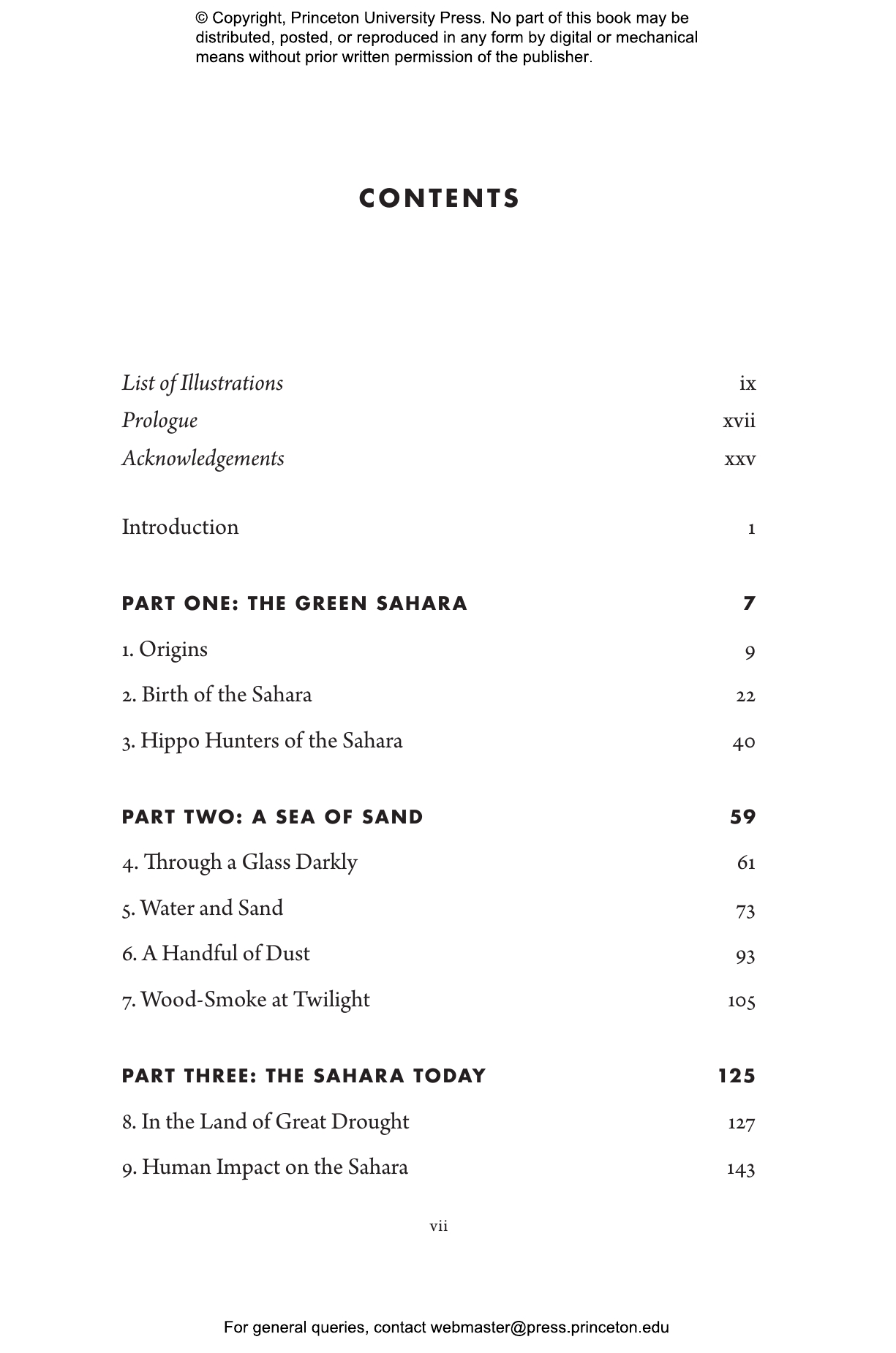The Sahara is the largest hot desert in the world, equal in size to China or the United States. Yet, this arid expanse was once a verdant, pleasant land, fed by rivers and lakes. The Sahara sustained abundant plant and animal life, such as Nile perch, turtles, crocodiles, and hippos, and attracted prehistoric hunters and herders. What transformed this land of lakes into a sea of sands? When the Sahara Was Green describes the remarkable history of Earth’s greatest desert—including why its climate changed, the impact this had on human populations, and how scientists uncovered the evidence for these extraordinary events.
From the Sahara’s origins as savanna woodland and grassland to its current arid incarnation, Martin Williams takes us on a vivid journey through time. He describes how the desert’s ancient rocks were first fashioned, how dinosaurs roamed freely across the land, and how it was later covered in tall trees. Along the way, Williams addresses many questions: Why was the Sahara previously much wetter, and will it be so again? Did humans contribute to its desertification? What was the impact of extreme climatic episodes—such as prolonged droughts—upon the Sahara’s geology, ecology, and inhabitants? Williams also shows how plants, animals, and humans have adapted to the Sahara and what lessons we might learn for living in harmony with the harshest, driest conditions in an ever-changing global environment.
A valuable look at how an iconic region has changed over millions of years, When the Sahara Was Green reveals the desert’s surprising past to reflect on its present, as well as its possible future.
Awards and Recognition
- Winner of the ASLI Choice Award, Atmospheric Science Librarians International
- Winner of the PROSE Award in Earth Science, Association of American Publishers
- Winner of the Special Book Award, Gourmand World Cookbook Awards
- Winner of the Award of Excellence in Plants and Environmental Change, Council on Botanical and Horticultural Libraries
"A detailed and authoritative account that reveals the rich and fascinating story of this unique landscape and its climate, geology and natural history. . . . Williams’s book offers a wonderful insight into how climate can transform the landscape across long stretches of time, as well as how delicately balanced are the ecosystems on which we depend."—P. D. Smith, The Guardian
"This vivid historical survey by Earth scientist Martin Williams is the result of a lifetime’s work."—Andrew Robinson, Nature
"Fascinating. . . . Engrossing. . . . When the Sahara Was Green covers the cyclical, gradual desiccation of the Sahara, the changing of its biomes, the nature of its current occupants, and even the question of its future. It’s formidably researched . . . but so warmly, approachably written that learning was never so pleasant."—Steve Donoghue, Open Letters Review
"Given Williams’s deep well of knowledge, this book could have been bogged down by technicalities and jargon. Instead, When the Sahara Was Green is admirably accessible to a broad audience with only basic knowledge of geography and earth sciences. Furthermore, the book stands out for the numerous clear and well-designed illustrations that explain complex concepts."—Leon Vlieger, Inquisitive Biologist
"Highly accessible . . . and filled with interesting facts about geological history."—Nicole Barbaro, Bookmarked
"[A] fascinating and informative introduction to the history of the Sahara, the past and present lifeforms it hosts, and its role in the wider planetary environment . . . Read this book and spread interest in Earth’s largest desert."—Jeffery Hirschy, H-Environment
"Martin Williams has written a magnificent and thought-provoking history of the Sahara. With infectious panache, he reconstructs the formation and geological history of the desert, and looks at the prehistoric peoples who once flourished by its long-vanished lakes and rivers. We learn of dramatic climatic episodes and of ingenious adaptations to extreme aridity that are still relevant today. This wonderful book gives us hope in our drier, warming world. A brilliant achievement.”—Brian Fagan, coauthor of Climate Chaos: Lessons on Survival from Our Ancestors
"Stone Age humans hunted hippos in what is now the Sahara Desert. Taking us in his geological and archaeological time machine, Martin Williams journeys from the distant past to the present and explores how plants, animals, and human communities have adapted to living in an arid land that has been, on occasion, well-watered and teeming with life."—James Rodger Fleming, Colby College
“Part personal reminiscence and reflection, part popular science, and part history, this book ranges widely, from the geological and climatic changes that have resulted in the Sahara as we know it to human evolution and modern environmental and political issues. Martin Williams’s formative experiences with archaeological and geological investigations in the region show through clearly and provide a valuable personal perspective.”—Nicholas Lancaster, Desert Research Institute
“This excellent book is unique in its focus on the green Sahara. To many, it seems unimaginable that the world’s largest desert was a savanna only five thousand years ago, and Martin Williams brings the Sahara’s captivating deep history into view. The anecdotes and first-hand experiences described are a great strength, and could only come from someone who has spent his life researching and working in the region.”—Nick Drake, King’s College London
“This fascinating book about the Sahara blends rigorous science with the author’s personal anecdotes and insights."—David Thomas, coauthor of The Kalahari Environment





















